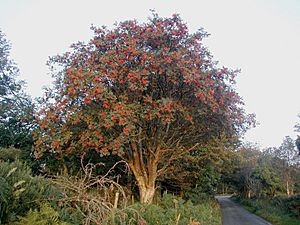Cloghanecarhan facts for kids
Quick facts for kids Cloghanecarhan |
|
|---|---|
| Native name Irish: Clochán Cárthainn |
|
| Lua error in Module:Location_map at line 420: attempt to index field 'wikibase' (a nil value). | |
| Type | ogham and ringfort |
| Location | Cloghanecarhan, Caher, County Kerry, Ireland |
| Elevation | 78 m (256 ft) |
| Built | c. AD 600 |
| Owner | state |
| Official name: Cloghanecarhan Ringfort & Ogham Stone | |
| Reference no. | 228 |
Cloghanecarhan is an amazing ancient site in County Kerry, Ireland. It features a special type of old fort called a ringfort and a unique stone with ancient carvings, known as an ogham stone. Together, they form a protected National Monument of Ireland.
Where is Cloghanecarhan?
Cloghanecarhan is found on the western side of the Iveragh Peninsula. It is about 7.2 kilometers (4.5 miles) south-southeast of the town of Cahersiveen.
A Look Back in Time
The ogham stone at Cloghanecarhan was put in place a very long time ago, around the year 600 AD. This was during the Middle Ages. The way the words are carved tells us it's a later example of ogham writing.
Right next to the ogham stone, you can see a stone cashel. A cashel is a circular stone fort. This one was used later for Christian burials.
What Can You See at Cloghanecarhan?
The ogham stone is a tall, narrow piece of slate. It measures about 208 centimeters (6.8 feet) tall. It used to stand at the entrance of the ringfort. Now, it rests a bit to the north.
The stone has an ancient message carved into its edge. It says something like "of Ec...án? son of Mac-Cáirthinn." This name, Mac-Cáirthinn, means "devotee of the rowan tree." The name of the area, Cloghanecarhan, might mean "ford of stepping-stones" or "stone beehive hut." There's a small stream nearby, and you can find stone huts inside the cashel.
The ringfort itself was known locally as 'Keeldarragh'. It's a circular area surrounded by a raised bank. The main entrance is on the east side. Inside the fort, you can find the remains of a circular hut. There are also three leachta, which are stone altars or burial places. You might also see a souterrain, which is an underground passage, and a cross slab, a stone with a cross carved into it.


